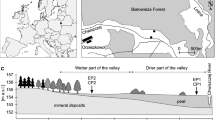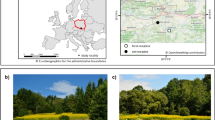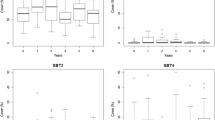Abstract
The effect of traditional management on the initial phase of invasion into mesic mown meadows was studied in the Křivoklátsko protected landscape area in Central Bohemia, the Czech Republic. In 1996, rhizome fragments of alien species native to Asia, i. e.Reynoutria japonica, R. sachalinensis and their hybridR. xbohemica were planted in experimental plots and their establishment recorded. Established plants were then subjected to the following six treatments which simulated the management practices traditionally used in the study area: mowing twice a year, grazing by goats and sheep separately at two different intensities, and a control plot. Plant survival was recorded in the two years following planting. In order to compare the effect of the growing period, the experiment withR. japonica was conducted in two subsequent years (1995 and 1996) thus allowing observations over three years on this species. The experiment was carried out in two sites (meadows), with three blocks of treatments established in each. Significantly better establishment was found inR. japonica andR. xbohemica than inR. sachalinensis. Survival of all three taxa was negatively effected by all the management treatments applied (P<0.001). In control plots with plants of all three taxa, there was virtually no mortality during the growing seasons of either year and the number of surviving plants decreased only in the winter. In the former two species, 38.5 ± 19.4% of plants survived the first winter, the corresponding figure for the latter being only 7.2 ± 6.1%. It can be concluded that traditional management provided it is applied continuously may represent an effective barrier against the invasion of theReynoutria species. Once ceased, the potential for invasion increases and if invasion occurs, special control measures are required to eliminate the invading plants effectively.
Similar content being viewed by others
References
Arnold M.L. &Hodges S.A. (1995): Are natural hybrids fit or unfit relative to their parents?Trends Ecol. Evol. 10: 67–71.
Bailey J.P. (1990): Breeding behaviour and seed production in alien Giant Knotweed in the British Isles. In:Palmer J. (ed.),The biology and control of invasive plants, Industr. Group. British Ecol. Soc., Cardiff, pp. 110–120.
Bailey J.P., Child L.E. &Wade M. (1995): Assessment of the genetics variation of British populations ofFallopia japonica and its hybridFallopia xbohemica. In:Pyšek P., Prach K., Rejmánek M. &Wade M. (eds.),Plant invasions: general aspects and special problems, SPB Academic Publishing, Amsterdam, pp. 141–150.
Bailey J.P. &Stace C.A. (1992): Chromosome number, morphology, pairing, and DNA values of species and hybrids in the genusFallopia (Polygonaceae).Pl. Syst. Evol. 180: 29–52.
Bastl M., Kočár P., Prach K. &Pyšek P. (1997): The effect of successional age and disturbance on the establishment of alien plants in man-made sites: an experimental approach. In:Brock J.H., Wade M., Pyšek P. &Green D. (eds.),Plant invasions: Studies from North America and Europe, Backhuys Publishers, Leiden, pp. 191–201.
Beerling D.J. (1991): The effect of riparian land use on the occurrence and abundance of Japanese knotweed (Reynoutria japonica) on selected rivers in South Wales.Biol. Conservation 55: 329–337.
Beerling D.J., Bailey J.P. &Conolly A.P. (1994):Fallopia japonica (Houtt.)Ronse de Craene (Reynoutria japonica Houtt.;Polygonum cuspidatum Sieb. & Zucc.).J. Ecol. 82: 959–979.
Beerling D.J., Huntley B. &Bailey J.P. (1995): Climate and the distribution ofFallopia japonica: use of an introduced species to test the predictive capacity of response surface.J. Veg. Sci. 6: 269–282.
Beerling D.J. &Palmer J.P. (1994): Status ofFallopia japonica (Japanese knotweed) in Wales. In:de Waal L.C., Child E.L., Wade P.M. &Brock J.H. (eds.),Ecology and management of invasive riverside plants, John Wiley & Sons, Chichester, pp. 199–211.
Brabec J. (1997): Experimentální studie vlivu obhospodařování na invazi vybraných druhů do lučních porostů (Experimental study of the effect of management on invasion of selected plants species into meadow communities). Thesis, Charles University, Praha.
Brock J.H. (1994): Technical note: standing crop ofReynoutria japonica in the autumn of 1991 in the United Kingdom.Preslia 66: 337–343.
Brock J.H. & Wade M. (1992): Regeneration of Japanes knotweed (Fallopia japonica) from rhizome and stems: Observation from greenhouse trials. In:IXème Colloque International sur la biologie des mauvaises herbes, Dijon, pp. 85–94.
Brock J.H., Child L.E., de Waal L.C. &Wade P.M. (1995): The invasive nature ofFallopia japonica is enhanced by vegetative regeneration from stem tissues. In:Pyšek P., Prach K., Rejmánek M. &Wade M. (eds.),Plant invasions: general aspects and special problems, SPB Academic Publishing, Amsterdam, pp. 131–139.
Chrtek J. (1990):Fallopia, Reynoutria. In:Hejný S. &Slavík B. (eds.),Květena České republiky (Flora of the Czech Republic) 2, Academia, Praha, pp. 359–366.
Crawley M.J. (1987): What makes a community invasible? In:Gray A.J., Crawley M.J. &Edwards P.J. (eds.),Colonization, succession and stability, Blackwell Scientific Publications, Oxford, pp. 429–453.
de Waal L. (1995): Treatment ofFallopia japonica near water: a case study. In:Pyšek P., Prach K., Rejmánek M. &Wade M. (eds.),Plant invasions: general aspects and special problems, SPB Academic Publishing, Amsterdam, pp. 203–212.
de Waal L.C., Child E.L., Wade P.M. &Brock J.H. (eds.) (1994):Ecology and management of invasive riverside plants, John Wiley & Sons, Chichester.
Hobbs R.J. (1989): The nature and effects of disturbance relative to invasions. In:Drake J.A., Mooney H.A., di Castri F., Groves R.H., Kruger F.J., Frjmánek M. &Williamson M. (eds.),Biological invasions: a global perspective, John Wiley & Sons, Chichester, pp. 389–405.
Hobbs R.J. &Huenneke L.F. (1992): Disturbance, diversity and invasion: implication for conservation.Conservation Biol. 6: 324–337.
Hobbs R.J. &Humphries S.E. (1995): An integrated approach to the ecology and management of plant invasion.Conservation Biol. 9: 761–770.
Hollingsworth M.L., Hollingsworth P.M., Jenkins G.I. &Bailey J.P. (1998): The use of molecular markers to study patterns of genotypic diversity in some invasive alienFallopia spp. (Polygonaceae).Molec. Ecol. 7: 1681–1691.
Horn P. &Prach K. (1995): Aerial biomass ofReynoutria japonica and its comparison with that of native species.Preslia 66 (1994): 345–348.
Hroudová Z., Zákravský P. &Frantík T. (1999): Ecological differentiation of Central EuropeanBolboschoenus taxa and their relationship to plant communities.Folia Geobot. 34: 77–96.
Hurlbert S.H. (1984): Pseudoreplication and the design of ecological field experiments.Ecol. Monogr. 54: 187–211.
Jalas J. &Suominen J. (eds.) (1988):Atlas florae europae: distribution of vascular plants in Europe 4, The Committee for Mapping the Flora of Europe and Societas Biologica Fennica Vanamo, Helsinki.
Kowarik I. (1995): On the role of alien species in urban flora and vegetation. In:Pyšek P., Prach K., Rejmánek M. &Wade M. (eds.),Plant invasions: general aspects and special problems, SPB Academic Publishing, Amsterdam, pp. 85–103.
Krahulec F., Marhold K. &Schmid B. (1999): Ecology of closely related plant species: an introduction.Folia Geobot. 34: 1–5.
Mandák B. & Pyšek P. (1997): Druhy roduReynoutria na území České republiky (Species of the genusReynoutria at the territory of the Czech Republic). In:Pyšek P. & Prach K. (eds.),Invazní rostliny v České flóře (Invasive plants in the Czech flora), Zprávy České Bot. Společn. 32, Mater. 14: 45–57.
Marigo G. &Pautou G. (1998): Phenology, growth and ecophysiological characteristics ofFallopia sachalinensis.J. Veg. Sci. 9: 379–386.
Neuhäuslová Z. et al. (1998):Map of the potential natural vegetation of the Czech Republic. Academia, Praha.
Pyšek P. &Prach K. (1993): Plant invasion and role of riparian habitats: a comparison of four alien to Central Europe.J. Biogeogr. 20: 413–420.
Pyšek P. &Prach K. (1994): How important are rivers for supporting plant invasions? In:de Waal L.C., Child L.E., Wade P.M. &Brock J.H. (eds.),Ecology and management of invasive riverside plants, John Wiley & Sons, Chichester, pp. 19–26.
Pyšek P., Prach K. &Mandák B. (1998): Invasions of alien plants into habitats of Central European landscape: an historical pattern. In:Starfinger U., Edwards K., Kowarik I. &Williamson M. (eds.),Plant invasions: ecological mechanisms and human responses, Backhuys Publishers, Leiden, pp. 23–32.
Pyšek P. &Pyšek A. (1995): Invasion byHeracleum mantegazzianum in different habitats in the Czech Republic.J. Veg. Sci. 6: 711–718.
Rejmánek M. (1989): Invasibility of plant communities. In:Drake J.A., Mooney H.A., di Castri F., Groves R.H., Kruger F.J., Rejmánek M. &Williamson M. (eds.),Biological invasions: a global perspective, John Wiley & Sons, Chichester, pp. 369–388.
Salisbury E.J. (1961):Weeds and aliens. Collins, London.
Schwabe A. &Kratochwil A. (1991): Gewässer-begleitende Neophyten und ihre Beurteilung aus Naturschutz-Sicht unter besondere Berücksichtigung Südwestdeutschlands.Norddeutsche Naturschutzakad. Ber. 4(1): 14–27.
Seiger L.A. (1997): The status ofFallopia japonica (Reynoutria japonica; Polygonum cuspidatum) in North America. In:Brock J.H., Wade M., Pyšek P. &Green D. (eds.),Plant invasions: Studies from North America and Europe, Backhuys Publishers, Leiden, pp. 95–102.
Stöcklin J. (1999): Differences in life history traits of relatedEpilobium species: clonality, seed size and seed number.Folia Geogot. 34: 7–18.
Sukopp H. &Starfinger U. (1995):Reynoutria sachalinensis in Europe and in the Far East: A comparison of the species ecology in its native and adventive distribution range. In:Pyšek P., Prach K., Rejmánek &Wade M. (eds.),Plant invasions: general aspects and special problems, SPB Academic Publishing, Amsterdam, pp. 151–159.
Sukopp H. &Sukopp U. (1988):Reynoutria japonica Houtt. in Japan und in Europa.Veröff. Geobot. Inst. ETH Stiftung Rübel Zürich 98: 354–372.
Tade Zoku K. (1965):Polygonum. In:Ohwi J. (ed.),Flora of Japan, Smithsonian Institute, Washington, pp. 405–413.
Thébaud C. &Debussche M. (1991): Rapid invasion ofFraxinus ornus L. along the Herault River system in southern France: the importance of seed dispersal by water.J. Biogeogr. 18: 7–12.
Usher M.B. (1988): Biological invasions of nature reserves: a search for generalisation.Biol. Conservation 44: 119–135.
Vitousek P.M., Walker L.R., Whitaker L.D., Mueller-Dombois D. &Matson P.A. (1987): Biological invasion byMyrica faya alters ecosystem development in Hawaii.Science 238: 802–804.
Williamson M. (1996):Biological invasions. Chapman & Hall, London.
Author information
Authors and Affiliations
Corresponding author
Rights and permissions
About this article
Cite this article
Brabec, J., Pyšek, P. Establishment and survival of three invasive taxa of the genusReynoutria (Polygonaceae) in mesic mown meadows: A field experimental study. Folia Geobot 35, 27–42 (2000). https://doi.org/10.1007/BF02803085
Received:
Revised:
Accepted:
Issue Date:
DOI: https://doi.org/10.1007/BF02803085




